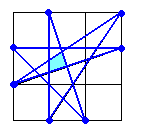Let $\mathcal{P}$ be a convex lattice polygon with $n$ vertices and let $\mathcal{L}$ be the set of all lattice points inside $\mathcal{P}$. For every $n \geq 5$, does there exist a point in $\mathcal{L}$ such that it also lies in the convex polygon bounded by (all) the diagonals of $\mathcal{P}$? How many such points are there? (//By diagonals I mean of course the lines different from the sidelines of the polygon which are connecting two vertices of $\mathcal{P}$.)
I proved a while ago that for $n=5$ there is such a point in $\mathcal{L}$. I also managed to show this now for $n \geq 6$ using a similar argument, yet it got more involved and I still need to check for potential bugs. Any ideas for the general case?

